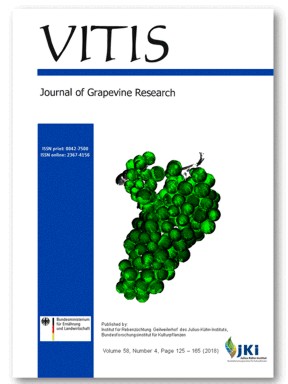Genetic inter-relationships among Chinese wild grapes based on SRAP marker analyses
DOI:
https://doi.org/10.5073/vitis.2018.57.151-157Keywords:
Vitis; species; genotypes; polymorphism; genetic diversity.Abstract
Sequence-Related Amplified Polymorphism (SRAP) markers were used to assess genetic inter-relationships among 39 grape genotypes. These included 22 indigenous Chinese grape species/varieties, the north American V. riparia and the European V. vinifera L. 'Thompson seedless' and 'Pinot noir'. Of the 72 SRAP primer combinations tested, 25 primers generated 135 reliable bands, with an average of 5.52 bands per primer pair. Further analysis shows that 106 of 135 bands were generated by 25 polymorphic primer pairs, with a polymorphism efficiency of 79 %. The similarity coefficients of SRAP polymorphism varied from 0.463 to 0.981 among the genotypes analysed. A dendrogram analysis divided the 39 Vitis accessions into 21 groups with similarity coefficients of 0.83. It reveals broadly similar genetic relationships among the genotypes examined to those previously determined using classical taxonomic methods. Our results define V. heyneana subsp. ficifolia and V. baihensis as subspecies of V. heyneana and V. bashanica, respectively. We question the placement of V. davidii var. cyanocarpa and V. davidii var. ningqiangensis as varieties in V. davidii.
Downloads
Published
Issue
Section
License
The content of VITIS is published under a Creative Commons Attribution 4.0 license. Any user is free to share and adapt (remix, transform, build upon) the content as long as the original publication is attributed (authors, title, year, journal, issue, pages) and any changes to the original are clearly labeled. We do not prohibit or charge a fee for reuse of published content. The use of general descriptive names, trade names, trademarks, and so forth in any publication herein, even if not specifically indicated, does not imply that these names are not protected by the relevant laws and regulations. The submitting author agrees to these terms on behalf of all co-authors when submitting a manuscript. Please be aware that this license cannot be revoked. All authors retain the copyright on their work and are able to enter into separate, additional contractual arrangements.



